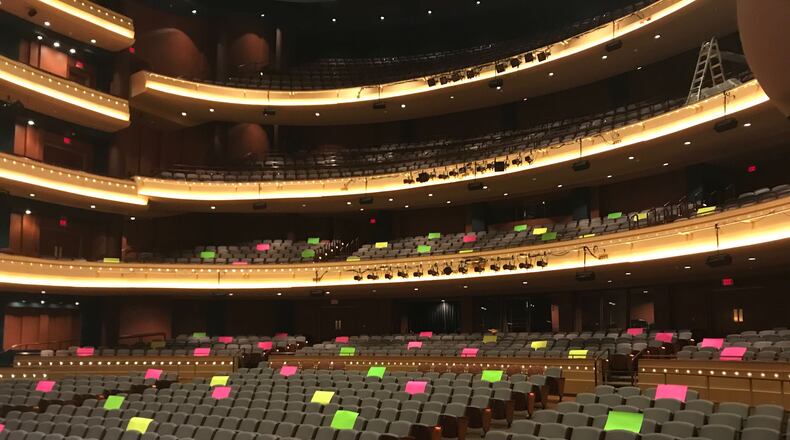During a media event Thursday, Dayton Live demonstrated what 15% capacity inside the Schuster Center’s Mead Theater would look like physically by using bright-colored construction paper and by crunching the numbers.
Even without real humans sitting in the audience, the pieces of paper showed how different a show would look under current COVID-19 restrictions.
“Even if this is a start, and I think we’re all glad it’s a start, it’s not a reopening,” said Ty Sutton, president and CEO of Dayton Live during the press conference. “I think looking at it visually really tells the story of what we’re talking about. ... It still gets me when I look out."
The Mead Theater has about 2,300 seats total, meaning 15% capacity should allow for 345 tickets to be purchased. However, to sell seats in properly social distanced pairs, only 272 seats could be filled in the theater, Dayton Live staff explained.
When calculating the revenue of a “best-case scenario” week-long showing at 15% capacity, the net loss taken by both Dayton Live and the individual artist or production performing would be over $400,000 per week.
For a Broadway production, a fraction of an audience does not mean a fraction of the expenses to put on the performance, Sutton said.
Dayton Live has trimmed its costs as much as possible, but according to Sutton, it still costs over $100,000 per week just to maintain facilities and operating expenses. For this reason, Sutton said he has not heard of any major theater company in Ohio that has reopened at 15% capacity.
“Think about the audience experience for something like this," Sutton said. "It’s one thing for a movie, but when you’re talking about a live performance, it’s a very different interaction. An audience is a part of a live show, they just are.”
As bleak as the view was looking out over an imaginary 15% filled venue, Sutton said he is still hopeful for some kind of season in 2021. In fact, more people bought new season tickets this year than any other time in the last 15 years. Sutton said he believes this is because people are excited for a return of the performing arts.
“If you look back on the Spanish Flu ... it was followed by the Roaring 20s,” Sutton said. “It took a year or two for everybody to get back, then it was the Golden Age of jazz and from an arts and culture standpoint, some of the most productive years our country and the whole world has ever had.”
For Sutton, it’s not a question of whether the demand for shows is there; it’s just a matter of when Dayton Live and other performing arts venues can resume meeting that demand financially.
The impact of the pandemic has been devastating for the live events industry. An estimated 12 million people in the industry are currently unemployed due to the coronavirus pandemic, according to organizers of the national Red Alert Day of Action initiative in September that advocated for assistance for the industry. Nearly 47% of Ohio’s arts and events industry workers are unemployed, which is about 300,000.
Sutton is encouraging the community to continue to contact legislators to voice support for the Save Our Stages Act and visit saveourstages.com. The act would have a huge impact on Dayton Live’s ability to continue operating, Sutton said.
One form of relief was recently announced — the city of Dayton Cultural Support Relief Fund. It will provide grants to performing and visual arts groups, libraries, museums and cultural institutions. Organizations may be eligible if they support painting, photography, writing, sculpture, theater, film, opera, dance, music, puppetry and other activities, city documents say. Information is available online at www.daytonohio.gov/bids.aspx.
FAST FACTS
A closer look at 15% capacity revenues versus expenses at The Mead Theatre inside the Schuster Performing Arts Center.
Regular seating capacity: 2,300
15% seating capacity: 345
Actual seating capacity with properly distanced pairs: 272
Potential revenue (272 seats at $70 each) for individual artist show: $19,040
Potential revenue (272 seats at $70 each over 8 performances) for Broadway show: $152,320
Typical expenses for individual artist show: $72,900
Typical expenses for Broadway show: $569,132
Projected net loss on individual artist show: $53,860
Projected net loss on Broadway show: $416,812
Source: Dayton Live
About the Author


